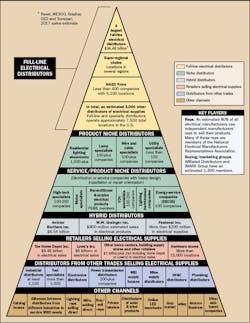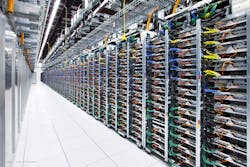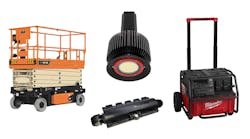Building EW’s Electrical Pyramid each year is always an interesting exercise for EW’s editors because it allows us to incorporate any changes in the individual channels of distribution into what become one of the most popular resources for analyzing the electrical wholesaling industry. While we don’t usually see many major variations from one year to another in EW’s Electrical Pyramid, we often get questions from readers about the various bricks in the pyramid or suggestions about adding additional channels.
In this year’s EW Pyramid, you will see that we added a brick in the pyramid for the members of PEARL (Professional Electrical Apparatus Reconditioning League), who focus on the sale of reconditioned or surplus electrical equipment that’s passed strict standards of reconditioning. We also decided to delete a brick for commercial system integrators, a channel for companies that specialize on the supply of products for building automation systems, until we see more companies providing this service.
We did dig into one of the larger channels in the EW Pyramid because of a question from readers. A wire and cable distributor was having difficulty identifying 200 other wire and cable specialists we listed in last year’s Pyramid, and that question set us on a mission to update our list of players in this niche.
Accounting for an estimated 13% of all products sold through distributors of electrical products ($13.4 billion), wire and cable is one of the core product niches in the electrical wholesaling industry. It’s a market unlike any other product area, with totally unique channels to market and all sorts of hybrid distributors that are part wholesaler and part manufacturer. It’s a segment of the electrical industry loaded with industry veterans with decades of industry experience, often with several different companies within the business. Terry Hunt, the founder of Houston Wire and Cable, once told an EW editor that in the wire and cable industry you may switch companies from time to time but you rarely leave the industry, much like the infamous Devil’s Island where you might switch prison cells, but you never leave the island.
No two wire specialists are exactly alike because so many of them differ in how they go to market; their customer focus; if they sell through or around full-line electrical distributors; and whether they perform the duties of distributors, or blend those services with some manufacturing operations. Few companies seem to have the same customer focus or package of value-added services. You have large specialty wire distributors like Omni Cable Corp., West Chester, PA, or Houston Wire & Cable, Houston, TX, that primarily function as traditional master distributors with a focus on providing a secondary source of supply for hard-to-find or “B” and “C” inventory items not ordered too often. For them, full-line electrical distributors are core customers. But plenty of specialty distributor sell directly to industrials, electrical contractors and other end users, and for them full-line distributors are their biggest competitors. Anixter Inc., Glenview, IL, is the biggest and best example of these wire specialists. Along with the distinction between these operating strategies is a history of heated battles between specialists that support and sell to electrical distributors and those that compete directly with them.
A key idiosyncrasy in this channel of distribution is that wire specialists may be both distributor and manufacturer. Along with stocking and reselling products from different wire and cable manufacturers, these companies build wire and cable assemblies as part of their custom cabling operations. They bundle and “connectorize” various types of cable into assemblies, and many also offer different insulation colors and stripe or otherwise identify cable according to customer specifications.
To get a handle on just how many wire specialists are out there now, EW’s editors found the Dun & Bradstreet Million Dollar Directory to be a valuable resource because in addition to listing distributors of electrical supplies under NAICS code 423610, it also offers clues on companies’ primary product focus through SIC (Standard Industrial Classification) Codes 50630300-50630306 for various sorts of wire and cable.
We visited the websites of all the companies on the D&B list that had wire and cable as a primary product focus and according to D&B did at least $10 million in annual sales and found more than 50 companies that were at least in part distributors. D&B also had more than 200 other companies with sales listed at under $10 million (most with sales under $3 million) that EW has not yet verified. Our best guess is that more than half of these other companies also function mainly or at least in part as distributors of wire and cable.
BUILDING YOUR OWN ELECTRICAL PYRAMID
Depending on how you need to analyze the channels of distribution in the electrical wholesaling industry, you could also do a deep dive (as EW’s editors did into wire and cable) into an individual channel of distribution using a source like the Dun & Bradstreet Million Dollar Directory that’s accessible for free at many local business libraries, or take a more local look at your market area.
While EW’s 2018 Electrical Pyramid is a snapshot of the electrical market as a whole, it can also be used as a tool to analyze the channels of distribution in your geographic market of choice. So, get out your magic markers and whiteboards and start drawing your own electrical pyramids (See www.ewweb.com’s “10 more Ideas for How to Use Your Own Electrical Pyramid.”) EW’s editors think this article does a pretty good job of summarizing the biggest channels to market in the electrical industry. If you find other bricks that belong in the pyramid, draw them in and send them to us at [email protected]. We may include them in our next edition of Electrical Wholesaling’s Electrical Pyramid.
One other key thought to remember before you dig into the valuable exercise of building your own electrical pyramid: Remember that there really isn’t any right or wrong combination of channels of distribution. EW’s Electrical Pyramid is in some ways more like a kaleidoscope than a snapshot of the electrical channel, in that the bricks in it shift on a product-by-product or market-by-market basis.
For instance, a manufacturer that wants to grow in the New York-New Jersey metropolitan area may have entirely different Electrical Pyramids for the five boroughs of New York and suburban Westchester County or Long Island in New York and Bergen, Hudson and Passaic Counties in New Jersey because the channels of distribution and local buying influences can be very different. And the bricks in the pyramid that a local electrical distributor will build to analyze his competition for a slice of that same market will look different from that manufacturer’s pyramid.
The Electrical Pyramid is going to be much more valuable if you build your own and customize it to your own unique market needs. But like lots of things, the devil is in the details. It’s a fun exercise, so don’t be afraid. Here’s how to get started.
Schedule at least a half-day. Invite your management team and best strategic thinkers to this session. If you can do it off-site in a conference room, all the better, but if time or budget don’t allow it, find a quiet room in your building where you can spread things out a bit.
Bring the right equipment. If you are leading the discussion and are a white-board type of guy or gal, you will have fun with this assignment. Bring ample erasable markers — you will be building an Electrical Pyramid brick-by-brick and will be thinking on the fly. Or, if you aren’t into white boards, get hold of a large roll of newsprint from an art supply or craft store and bring along a handful of markers. Other resources you should have on-hand include laptops (internet access is a big plus in this meeting); copies of this article; and sticky notes. If a PDF of this article would be helpful for the session, contact EW at [email protected]. The analysis in this article will provide a high-altitude overview of the various channels (bricks) in each tier of the pyramid. Your job in this exercise is to bring this analysis down to ground level for the market area under discussion, and identify all the key players in it.
If you want to get creative and make it a fun hands-on exercise, you may even want to try bringing along some large wooden building blocks, and Legos or Duplo bricks. Assign the person in the room with the most artistic talent with the job of inscribing each brick with the channel of distribution under discussion.
Assign one person to be the “scribe.” If you are going with the building block idea, you have your man or woman. But make sure you have someone who is copying down all the ideas sure to be flying around the room.
Build your pyramid level-by-level, starting with full-line distributors. Here’s where you will need a copy of EW’s Electrical Pyramid illustration shown above. You may find it easiest to start at the top with full-line electrical distributors and work your way down through the seven tiers shown in the illustration. The rest of this article will walk you through each tier:
- Full-line electrical distributors
- Product niche distributors
- Service/product niche distributors
- Hybrid distributors
- Retailers selling electrical supplies
- Distributors from other trades selling electrical supplies
- Other channels
- Web-based companies
If you are a distributor, go around the room and start listing all competitors. Group them by national chain, regional chain or local independent. If you are an electrical manufacturer or independent manufacturers’ rep, do the same thing, but you may want to group them by the amount of business you do, don’t do or want to do with them. Depending on the type of analysis you are doing you may also want to pencil in which buying/marketing groups the distributors are in, if any.
And don’t forget to factor in the huge role independent reps play in any local market. Depending on your position in the market (distributor, rep, manufacturer, consultant, etc.) you may or may not want to list and profile all of the independent manufacturers’ reps in the market, and possibly the factory-employed field salespeople who cover the market as well.
You may find that creating an Electrical Pyramid leads to the creation a “customer pyramid,” where you analyze your market’s key accounts by size, type of company, market focus, the level of service required and how they buy product. And remember psychologist Abraham Maslow’s “hierarchy of needs” pyramid from that Psychology 101 class, which illustrated our basic need for food, water, shelter, companionship, respect, etc.? You could draw up a customer’s “hierarchy of needs,” where you illustrate the importance of price, delivery, education, return policy, etc. And don’t forget to check out the Customer Pyramid at www.ewweb.com.
Okay, now the hard work starts. Compiling a list of distributors (or reps) in your market may unearth a few surprises and provide some valuable information. But to make this information really work for you, sketch out a profile for each of these companies and drill down to their strengths and weaknesses. The basic company profile should include key management personnel; estimated sales volume; market share; and primary market focus. You also need to get answers from your assembled team to questions such as:
- “What value-added services does this company provide that we currently don’t offer?”
- On the flip side, “Which services do we offer where we have a clear advantage?”
- Who are their biggest accounts?
- With which customers are they most vulnerable?
The Five Largest Full-Line Distributors Accounting for 33% of the Market. The electrical wholesaling industry continues to consolidate, and as mentioned earlier over the last few years the five largest national distributors have increased their market share to a third of a $100 billion-plus market, and the Top 200 largest distributors (see EW’s June issue) account for 61% of total sales.
Product Specialists. Now move down to the next tier of the Electrical Pyramid. Go around the room and get people to brainstorm about all of the niche distributors in your market area that focus on a specific product category. The biggest product specialists typically include residential lighting, lamps, wire and cable and utility products. Others include fuses, voice-data-video (VDV) products and utility supplies. You may be surprised by how many product specialists in your market area compete with you on a few product lines. Depending on how in-depth you want to go with your analysis, you may or may not want to develop company profiles for each of these product specialists.
Service/Product Niche Distributors. Find out what ESCOs and lighting maintenance companies are doing in your market. Service/product niche distributors have a heavy emphasis on design, installation or repair. Although they sell electrical supplies, product sales may not be their primary function. These companies focus on providing a complete service solution to their customers.
Pay special attention to ESCOs, which provide the most sophisticated package of design, financing, technical assistance, audit and, in some cases, installation services in the energy market. The sale of electrical products is a relatively small piece of the overall package of products and services that ESCOs provide. Many ESCOs are looking for distributors to provide local warehousing support and logistics for their lighting retrofit projects. The National Association of Energy Service Companies (NAESCO), Washington, DC, offers some good insight into the world of ESCOs at www.naesco.org.
You should also pencil in lighting-maintenance companies into this tier of your pyramid. These companies, which typically have contracts for the maintenance and retrofit of lighting systems in stores, parking lots and other retail or commercial facilities, are emerging as skilled players in the energy game.
If you want to get a sense of how far these companies have evolved, check out the training resources at www.nalmco.org, the web-site for the interNational Association of Lighting Management Companies (NALMCO), Ankeny, IA. NALMCO’s training resources help school its members in the latest in energy-efficient lighting systems. Some full-line electrical distributors are members of NALMCO, including Border States Industries, Fargo, ND; Facility Solutions Group, Austin, TX; and Graybar Electric Co., St. Louis.
Hybrid Distributors. Don’t overlook Grainger and Fastenal. Grainger and Fastenal are tough to categorize because they don’t carry a full line of electrical products. But they are definitely competitors to full-line distributors because of their intense focus on the industrial MRO and facility maintenance markets, rock-solid balance sheets and progressive internal operations. Electrical products account for more than 15% of Grainger’s total sales. But because of its sheer size, willingness to invest in its e-business capabilities, distribution network and branch infrastructure, the company is a formidable competitor. If you have a Grainger branch in your neighborhood, add a brick to your pyramid for them.
By some measures, Fastenal may be a peripheral player in the electrical market. But with almost 4.9% of its $4.39 billion in sales (an estimated $215 million) in electrical products; more than 12,000 electrical stock-keeping units (SKUs) listed on www.fastenal.com and 2,034 U.S. branches, you need to keep an eye on them. And if you want to learn about something really interesting, do some research on the company’s FAST Solutions vending program, where it has more than 71,000 vending machines already installed in customer locations. Add another brick to your pyramid for them.
You may also want to include Anixter International Inc., Glenview, Ill., on this tier of your pyramid if they have any locations nearby. They could also be called a product specialist because of their primary emphasis on wire and cable, but they also sell other electrical products and provide some unique customized supply chain services for customers. EW’s editors put them in this tier. With their acquisition of HD Supply they are definitely a hybrid distributor — part wire and cable specialist, part utility distributor and part full-line distributor.
Retailers Selling Electrical Supplies. Keep an eye on what Home Depot and Lowe’s are doing. When you figure that Home Depot or Lowe’s does roughly 9% of their total sales in electrical products, you realize why you still have to watch what these big boxes are doing in their electrical aisles. It’s true that a huge chunk of their electrical business is in residential fixtures, which may or may not be a concern. And although all of the talk about home centers going after the contractor market in a big way seems to have died down a bit, both still provide home installation services and Lowe’s appears to have a fairly large residential solar installation play in its Sungevity service.
And here’s an interesting side note that shows just how big electrical sales are at Big Orange. Home Depot’s 2017 10K filing says its electrical aisles account for 5% ($5.04 billion) and its lighting aisles account for 4.4% ($4.41 billion) of total 2017 sales of $100.9 billion.
Distributors from Other Trades Selling Electrical Supplies. That distributor down the street may be a competitor. When you have at least 1,000 industrial distributors, 1,000 tool specialist distributors, and more than 200 specialists in power transmission products in the United States, you know some electrical sales are flowing through these often-overlooked channels. If you have any of these types of distributors in your market, as well as distributors of electronics components, HVAC equipment, plumbing supplies or other specialty distributors, they may be worth further study to see what kinds of electrical products they might be stocking.
It makes a lot of sense to get to know the distributors from other trades in your local market area. In a sense, you are in the same business but are just shipping different stuff in the boxes. Find some non-competing distributors from other trades and compare best practices in sales, warehousing, delivery, e-business and operations. You may also want to consider joining the National Association of Wholesaler-Distributors (NAW), Washington, DC (www.naw.org), which provides some terrific venues for networking with distributors from other trades and an insider’s perspective on legislative issues of interest to distribution firms.
Other Channels. Always changing but always growing. Any single brick in this level of the EW Electrical Pyramid probably may or may not account for a ton of electrical sales in your market. This level of the Pyramid may be toughest to track because it’s where the new and potentially competing channels of distribution first start out.
Do you have any reps in the spec-grade lighting niche selling direct? Pencil them in. And if solar is growing in your market area, find out who is selling the photovoltaic (PV) equipment. It might be a small PV contractor who is also a dealer for a limited number of lines.
Another hotly debated sales channel is the manufacturers selling direct. Outside of providing large quantities of wire and cable for massive projects in the utility market; gigantic turnkey switchgear or automation projects; spec-grade lighting packages; and now LED lighting solutions, this historically hasn’t been a widespread issue in the mainstream electrical wholesaling industry. However, we expect more lighting manufacturers to sell their customized LED lighting solutions direct to end users.
Online Merchants. Depending on your market position, these bricks in the pyramid may be changing the fastest. The most obvious bricks here include www.amazon.com, www.ebay.com and the online LED merchants mentioned earlier.
Summary. After you build your own Electrical Pyramid, check out www.ewweb.com for more information that EW’s editors have posted on some of the fastest-growing alternative channels of distribution over the years. Just type “electrical pyramid” into the search engine.
UNTANGLING THE WORLD OF WIRE & CABLE SPECIALISTS
Wire and cable specialists come in all sizes and shapes, but several common threads become quickly apparent when you visit the websites of the wire-and-cable specialty distributors listed in D&B Million Dollar Directory. Below are some examples of wire & cable distributors focusing on customers in several primary areas: serving full-line electrical distributors, the voice/data/video (VDV) market, OEM/industrial customers, aviation/defense & mil-spec and renewables. (Companies listed alphabetically, not by size.)
DISTRIBUTOR-FOCUSED
A.E. Petsche (Arrow Electronics)
Allied Wire and Cable
Allstar Cable Products Inc.
Anixter
Distributor Wire & Cable
Electrowire (Genuine Cable
Group/EIS)
Houston Wire & Cable
IEWC Global Solutions
Metro Wire & Cable Corp.
Omni Cable Corp.
Windy City
Wirexpress
RENEWABLES
American Wire Group
Resitech Industries
Wind Turbine & Energy Cables Corp.
VDV EMPHASIS
Bay State Wire & Cable
Capital Electric Wire & Cable
Datatech
Firefold
Interstate Wire & Cable Co.
MCI Ashville
Norfolk Wire & Electronics
Primus Cable
Supply Solutions
OEM / INDUSTRIAL
Capital Electric Wire & Cable
Priority Wire & Cable
TPC Wire & Cable
USA Wire & Cable
AEROSPACE / DEFENSE / MIL-SPEC
PIC Wire & Cable (Angelus Corp.)
SEA Wire & Cable
Whitmore/Wirenetics
Wiremasters






